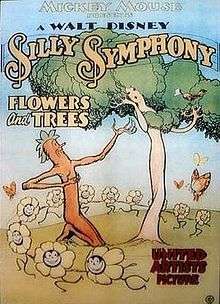Flowers and Trees
Flowers and Trees is a 1932 Silly Symphonies cartoon produced by Walt Disney, directed by Burt Gillett, and released to theatres by United Artists on July 30, 1932.[2] It was the first commercially released film to be produced in the full-color three-strip Technicolor process[3] after several years of two-color Technicolor films. The film was a commercial and critical success, winning the first Academy Award for Best Cartoon Short Subject.[2]
| Flowers and Trees | |
|---|---|
 theatrical release poster | |
| Directed by | Burt Gillett |
| Produced by | Walt Disney |
| Animation by | Les Clark David Hand Tom Palmer |
| Color process | Technicolor |
Production company | |
| Distributed by | United Artists |
Release date | July 30, 1932 |
Running time | 8 minutes[1] |
| Country | United States |
| Language | English |
Plot
During spring the flowers, mushrooms, and trees do their calisthenics. Some trees play a tune, using vines for harp strings and a chorus of robins. A fight breaks out between a waspish-looking hollow tree and a younger, healthier tree for the attention of a female tree. The young tree emerges victorious, but the hollow tree retaliates by starting a fire. The plants and animals try to extinguish or evade the blaze. By poking holes in clouds and making it rain, the birds manage to put out the fire, although the hollow tree perishes in the flames after getting caught up in them himself. The young tree then proposes to the female tree, with a caterpillar serving as a ring, and they embrace as a 12-color rainbow forms behind them.
Production
In May 1932, the first three-strip Technicolor camera was completed.[4] Herbert Kalmus wanted to test it in the animation field, giving the company time to build enough cameras to offer the whole movie industry, but could not find any interested animators. Finally Walt Disney agreed to try it as an experiment on Flowers and Trees,[4] which was already in production in black-and-white, and ordered the cartoon redone in color. The color animation caused the production to run over budget, potentially ruining Disney financially, but the cartoon proved so popular that the profits made up for the budget overage.[5]
Impact
As a result of the success of Flowers and Trees, all future Silly Symphonies cartoons were produced in three-strip Technicolor. The added novelty of color helped to boost the series' previously disappointing returns. Disney's other cartoon series, the Mickey Mouse shorts, were deemed successful enough not to need the extra boost of color, remaining in black-and-white until The Band Concert (1935).
Disney's exclusive contract with Technicolor, in effect until the end of 1935, forced other animation producers such as Ub Iwerks and Max Fleischer to use Technicolor's inferior two-color process or a competing two-color system such as Cinecolor.
Accolades
Flowers and Trees was the first animated film to win an Oscar at the fifth Academy Awards in 1932. It won an Oscar for best "Short Subjects, Cartoons", a category first introduced that year.[6]
Home media
The short was released on the 2001 Walt Disney Treasures DVD box set Silly Symphonies.[2]
References
- Heraldson, Donald (1975). Creators of Life. Drake. p. 251.
- Merritt, Russell; Kaufman, J. B. (2016). Walt Disney's Silly Symphonies: A Companion to the Classic Cartoon Series (2nd ed.). Glendale, CA: Disney Editions. pp. 112–113. ISBN 978-1-4847-5132-9.
- Robertson, Patrick (2011). Robertson's Book of Firsts. London: Bloomsbury. Retrieved 24 May 2017.
- Kalmus, Herbert (December 1938). "Technicolor Adventures in Cinemaland". Journal of the SMPE. Retrieved 7 December 2017.
- Mosley, Leonard (1990). Disney's World. Scarborough House. pp. 136–137. Retrieved 7 December 2017.
- Glenday, Craig (2013). Guinness World Records. pp. 208. ISBN 9781908843159.